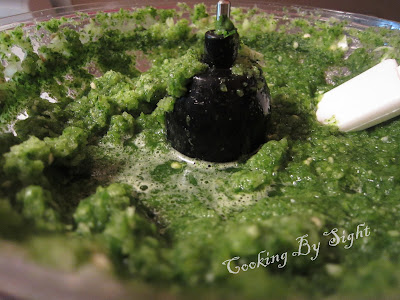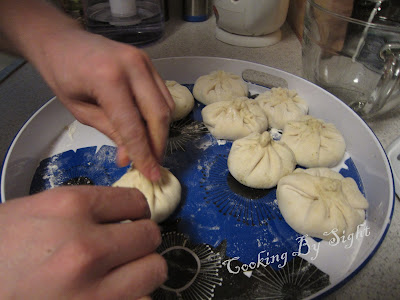Khinkali
Pelmeni, manti, maultaschen, jiaozi, mandu, pasteles, kubbeh, khinkali.
What do all of these have in common? They are all dumplings. Nearly every civilization on Earth has a dumpling in some form or other. Some are vegetarian, some are filled with meat, and some are simply bits of dough. The manner in which they are prepared varies from culture to culture as well. For example, in Uzbekistan and Kazakhstan, manti are steamed, whereas in Armenia they are first browned in butter and then boiled or steamed in either a chicken- or tomato-based broth. Some cultures serve dumplings as part of a soup and others consider the dumplings to be the main course, sufficient by themselves or perhaps with a dipping sauce.
Khinkali are of Georgian origin, although they are also prepared in Armenia and other parts of the Caucasus region. They are made with a mixture of beef and pork (occasionally with lamb), cilantro, onions and plenty of garlic. In size, khinkali are similar to the more widespread manti, which can be found across all of Central Asia, as well as the Muslim republics of the Caucasus and in Armenia. However, they are not steamed, but are simply boiled in salted water.
In Ossetia, where my husband grew up, khinkali are often made by a group of friends or relatives. It can be something of a chore to make enough dumplings by oneself to feed a crowd, but as the saying goes, 'many hands make light work'. In a kitchen surrounded by friends and family, all working together to form the khinkali dumplings, the work turns into fun. And of course, at the end of it all, everyone gets to enjoy the delicious, juicy fruits of their labor.
To make khinkali, you will need the following items:
For the dough:
- 6 C bread flour
- 2 tsp salt
- 2 eggs
- 2 C cold water
For the meat filling:
- 1 lb ground beef (use no leaner than 92%, or else the meat will be dry)
- 1 lb ground pork (as with the beef, do not use lean meat)
- 1 large onion, cut in wedges
- 1 bunch cilantro, stems mostly removed
- 1 jalapeno, roughly chopped
- 2 anaheim chilies, roughly chopped
- 8 cloves garlic
- 2 tsp salt
You will also need a deep stockpot and a food processor.
The first step is to prepare the dough. It will have to sit for 30 minutes, so make sure you put that together before you make the filling.
 Combine the flour and salt in a food processor. Pulse to mix it. Now, through the feed tube with the machine running, pour in the eggs, one at a time. Let that mix in completely. Next, slowly pour in the cold water. By the time that you've poured it all in, your dough should have formed a large mass in the food processor bowl. Once it has done that, scrape it out onto a floured work surface.
Combine the flour and salt in a food processor. Pulse to mix it. Now, through the feed tube with the machine running, pour in the eggs, one at a time. Let that mix in completely. Next, slowly pour in the cold water. By the time that you've poured it all in, your dough should have formed a large mass in the food processor bowl. Once it has done that, scrape it out onto a floured work surface.
Knead in as much flour as you can, and keep going until you have a very hard dough. Form it into a ball, cover with a clean kitchen towel (not terrycloth, or you will be picking fuzz out of your dumplings...never an attractive sight) and let it rest for about 30 minutes.
 Meanwhile, it's time to get the filling ready. After you've washed your food processor, put the onions in and process them until they are pureed. With the machine still running, add the cilantro, peppers and garlic through the feed tube.
Meanwhile, it's time to get the filling ready. After you've washed your food processor, put the onions in and process them until they are pureed. With the machine still running, add the cilantro, peppers and garlic through the feed tube.  Continue processing until everything is pureed. It will be a very juicy mixture, but this is exactly what you want.
Continue processing until everything is pureed. It will be a very juicy mixture, but this is exactly what you want. It should be a very wet mixture so that it will make a juicy filling, rather than a spiced hamburger patty encased in dough.
It should be a very wet mixture so that it will make a juicy filling, rather than a spiced hamburger patty encased in dough. When the 30 minutes are up, it's time to roll out the dough and form the dumplings! First though, pour about six quarts of water into your stockpot and heat to boiling. While your water is heating up, divide the dough into two logs, each about 12 inches long.
When the 30 minutes are up, it's time to roll out the dough and form the dumplings! First though, pour about six quarts of water into your stockpot and heat to boiling. While your water is heating up, divide the dough into two logs, each about 12 inches long. Cut 12 1-inch rounds from each log and roll them out to about 7 inches in diameter (about 2 or 3 mm thick). Make sure to use plenty of flour so they don't stick to the counter or each other.
Cut 12 1-inch rounds from each log and roll them out to about 7 inches in diameter (about 2 or 3 mm thick). Make sure to use plenty of flour so they don't stick to the counter or each other. Gather the edges in an accordion-pleat shape and pinch to seal at the top. Pinch off any excess dough at the top (leaving a top 'hat' about 1/4 to 1/2 inch tall).
Gather the edges in an accordion-pleat shape and pinch to seal at the top. Pinch off any excess dough at the top (leaving a top 'hat' about 1/4 to 1/2 inch tall).  By now, your water should have come to a rolling boil; add about a tablespoon of salt. Using a slotted spoon, carefully slide each dumpling into the water. Only cook one dozen at a time! Stir gently within the first minute or two to prevent the khinkali from sticking to each other or the pot (and thus increasing the risk of bursting).
By now, your water should have come to a rolling boil; add about a tablespoon of salt. Using a slotted spoon, carefully slide each dumpling into the water. Only cook one dozen at a time! Stir gently within the first minute or two to prevent the khinkali from sticking to each other or the pot (and thus increasing the risk of bursting).
When the water returns to a boil, set the timer for 15 minutes. While the first batch is cooking, you can work on forming the next dozen, so they will be ready to go in as soon as the first come out.
At the end of the 15 minutes, gently remove the dumplings, again using a slotted spoon. Place them on a serving platter and serve hot. Khinkali are traditionally served with no accompaniment aside from black pepper and a good ale or dark beer. When you eat them, be sure to hold them 'hat' side down, take a small bite and drink the flavorful broth first. Also, don't eat the tops! At the end of the meal, look around to see who has the driest plate and the most tops.
Now I have a question for my readers: Which dishes would you like to see on this blog? I am open to suggestions for just about anything! Georgian, Russian, Mediterranean, Central Asian or Middle Eastern - I will research the recipes, make them and post the results here!














Comments
Post a Comment